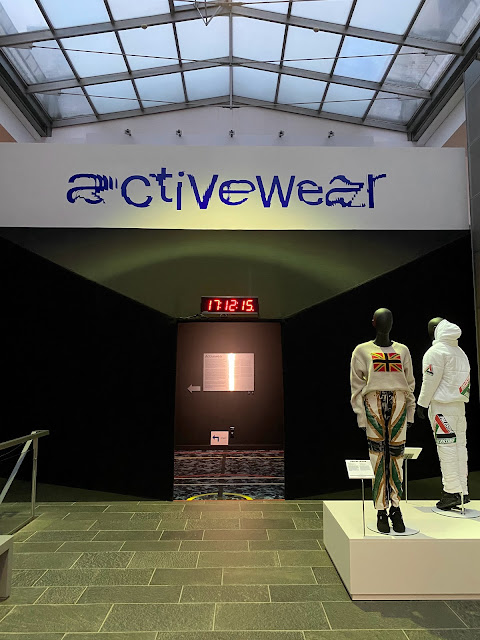06.06.21-30.12.21
More than ever, fashion is inspired by the world of sports. Cycling shorts, hoodies and sneakers are taking over the catwalk. Designers are drawn to technical materials such as neoprene, spandex and tulle. Fashion houses engage in lucrative collaborations with athletes and sports brands. High time for an exhibition that explores the exciting relationship between fashion and sports! Has activewear reached its peak or will it become a lasting trend?
Guest curators Elodie Ouédraogo and Olivia Borlée
These two former Olympic athletes are the figureheads of Belgian activewear, making them the ideal guest curators for this exhibition. They also play a role in the campaign image: Ronald Stoops immortalized them on camera, wearing an outfit by their favourite Belgian designer, Glenn Martens of Y/Project. But Elodie and Olivia are not only the faces of the exhibition. They also feature as the voices on your audio guide, showing you around personally and sharing their insights with you. To top it all off, they act as protagonists in Second Skin, A Virtual Trophy, a new digital artwork created by Frederik Heyman, whose previous collaborations include Lady Gaga, Nike and Hypebeast.
A dazzling race through a thematic exhibition
Activewear presents various themes in which street- and sportswear have influenced the world of fashion. Focusing on the European context from 1850 to the present day, you will discover designers, clothes and accessories at the intersection of fashion and sports.
Functional, technical textiles are one of the distinguishing features of sportswear. Incidentally, these are also well-suited for everyday wear. Clever designers had already caught on to this in the 1920s, when they started using the pleated fabric of tennis dresses in their conceptions for movement-friendly casual wear. But the exhibition also shows how contemporary designers and fashion houses use innovative sports fabrics to their advantage. For example, Off-White and Viktor & Rolf launched models in tulle dresses onto the catwalk, Walter Van Beirendonck shows a preference for spandex cycling jerseys, and emerging talents such as Craig Green and Simone Rocha like collaborating with Italian luxury brand Moncler, so they can get creative with the down linings typically used in skiwear. Our guest curators' love for high-performance materials is also clearly felt in the selection of pieces by Bioracer, Suzanne Oude Hengel and Jasna Rok.

One of the main themes in Activewear is freedom of movement and exercise. A nice example of this can be found in the 1980s, when designers like Gianni Versace responded to the fitness hype, spearheaded by Jane Fonda, by presenting sculpted figures in close-fitting and revealing designs. Or later, during the new millennium, when Dirk Bikkembergs turned the athletic, masculine body into the be-all and end-all of his designs and branding.

A quick look at fashion history shows that activewear is not a new phenomenon, and that its earliest traces date back to classical antiquity. The exhibition, however, takes 1850 as its starting date, showing striking parallels between then and now. Like today, the focus in the late nineteenth and early twentieth century was on a healthy and sporty lifestyle. Women became more active and took up walking, cycling, horse riding, tennis, boating and archery. This affected their clothing: fabrics and cut were adjusted, decoration was limited and dresses became looser. After the First World War, designers such as Jean Patou and Gabrielle ‘Coco’ Chanel went one step further and used sportswear as a tool for female emancipation.
As you’ll discover in the exhibition, the line between sportswear, streetwear and activewear is not always clear cut. Streetwear is closely related to youth subcultures, such as hip hop, skating and surfing. At the same time, it also contains sportswear elements, such as track suits, baseball caps and sneakers. Designers pick up elements from these subcultures, but process them in their own way. Activewear presents Raf Simons as one of the most idiosyncratic interpreters of this aesthetic.
Over the past ten years, the largest fashion houses have clearly focused on activewear. Two striking examples are the appointment of Kim Jones as artistic director at Dior Men and Virgil Abloh at Louis Vuitton, which also ensured a younger and more masculine audience. A visible consequence of this ‘masculinization’ is the trend to only launch or ‘drop’ sneakers in larger sizes. These often become collectables, such as the Air Jordan 1 High OG Dior or the collabs between Raf Simons and Adidas. You can admire them in the sneaker corner of the expo.
Activewear showcases designs from Botter, Thom Browne, Chanel, Christian Dior Couture, Jean Paul Gaultier, Craig Green, Gucci, Lacoste, Missoni, Marc Audibet, Moncler Genius, Azzedine Alaïa, Off-White, Prada, Marine Serre, Raf Simons, among others , Stella McCartney, Walter Van Beirendonck, Louis Vuitton, Virgil Abloh, Y / Project, Yohji Yamamoto.
www.modemuseumhasselt.be




































No comments:
Post a Comment